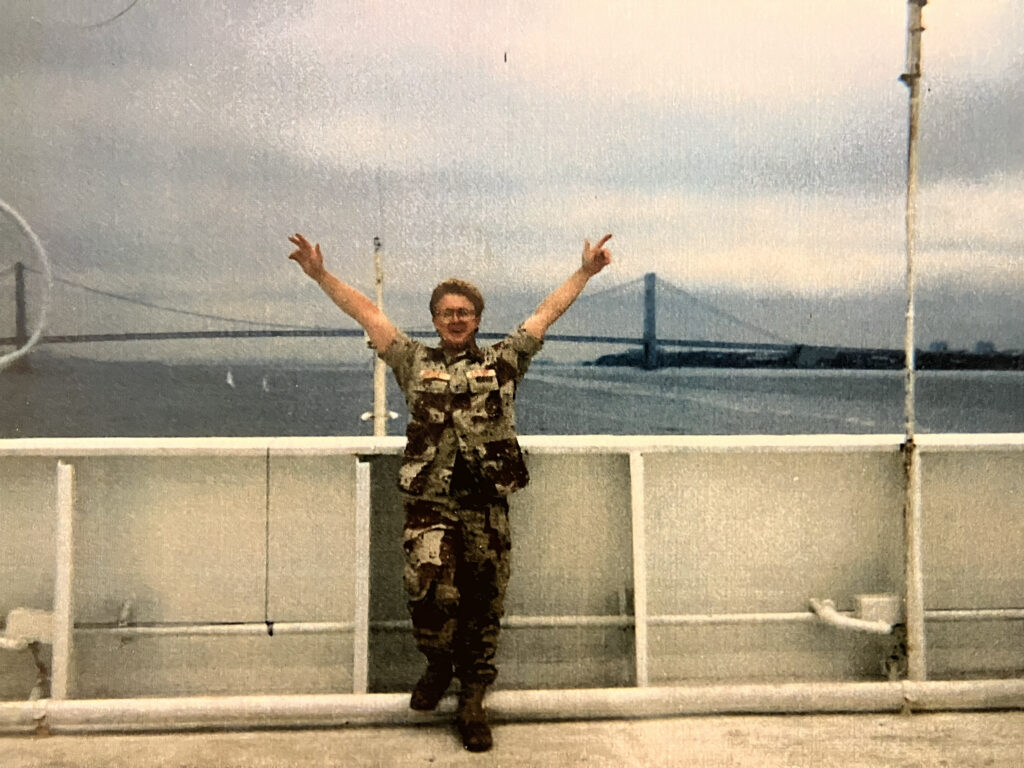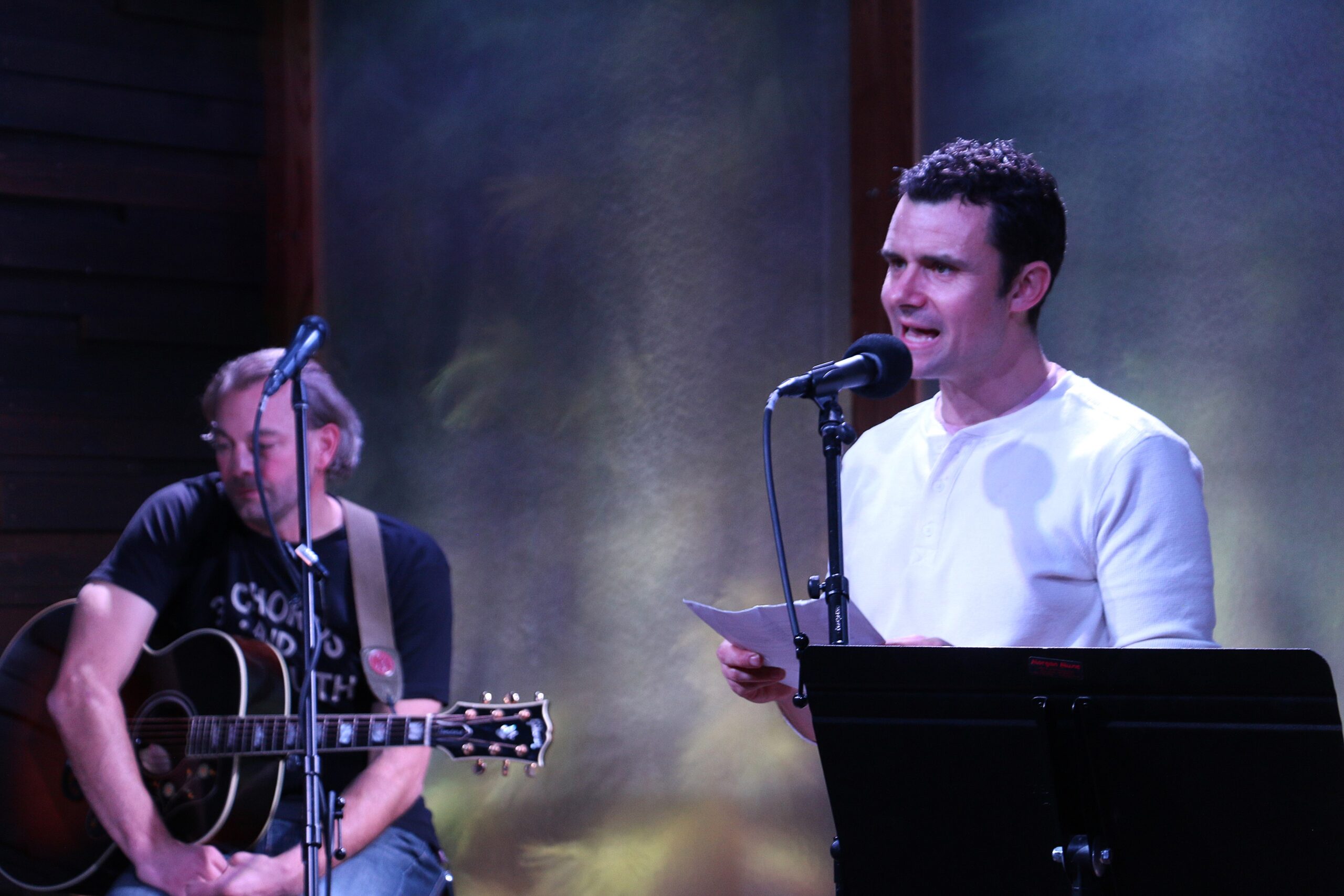Sending a message in a bottle has been romanticized for centuries. People have even cast bottles for scientific purposes. And as author B.J. Hollars tells us, it helped one Wisconsin veteran connect with humanity on a deeper level.
Hollars shared his story “Hope Floats” at a live storytelling event hosted by Wisconsin Public Radio’s “Wisconsin Life” and the Chippewa Valley Writers Guild. It was held on Nov. 14, 2024 in Eau Claire, Wisconsin at The Lakely.
==
Shortly before midnight on June 28, 1991, 26-year-old Sgt. Ted Simpson gripped a wine bottle, peered out at the Atlantic, and — from his place aboard the cargo ship — threw it as far as he could.
The bottle soared end over end before splashing into the dark water. Whatever happened next was out of his hands; the message he’d tucked into that bottle was now at the mercy of the waves.
Sgt. Simpson, who’d spent the last three years serving for the 18th Airborne Corps during the Gulf War, was also at the mercy of the water. Yet after three years as a member of a helicopter crew, his last and latest mission [serving as a cargo escort] seemed the safest way to end his military career and return home to Wisconsin.
Ted and the rest of the crew had boarded the cargo ship 23 days before. Their journey from a port in Saudi Arabia to the military ocean terminal near the Statue of Liberty would transport them over 10,000 miles in 31 days. However, within a few weeks, boredom set in.
“It was just the same scene day after day,” Ted recently shared from his home in Eau Claire. “And so I started to get creative.”

Sgt. Ted Simpson, now of Eau Claire, Wisconsin, aboard a U.S. military cargo ship in 1991, shortly after he threw a fated message in a bottle overboard. Photo courtesy of Ted Simpson
One evening, about three weeks into their journey, Ted glanced up from the book he was reading in the ship’s rec room to notice an empty wine bottle on a nearby table.
“Heck,” Ted thought, “I should put a message in that bottle.”
Ted began working on his letter, which included his name, rank and recent service in Operation Desert Storm.
Inspired by The Police’s hit song, “Message in a Bottle,” Ted allowed his letter to serve as his own “S.O.S. to the world.” After three years of enduring a front-row seat to the horrors of war, he was grateful — for this last mission — to have found a way to serve as an emissary for peace. After he completed his letter — adding his parents’ home address in Cedarburg — he tucked it into the bottle and corked it.
Yet Ted knew that a cork could hardly withstand an ocean’s worth of water. Ted determined that his best bet to preserve his letter would involve dipping the top of the bottle into a thick latex paint, of which the ship was never in short supply. The next day, Ted dipped the bottle into the paint until he’d created a dry seal nearly a fourth of an inch thick.
At last, the bottle was ready to go.
June 28, 1991, was a calm, dark night in the middle of the Atlantic. The full moon hung like a prop in the sky while algae’s phosphorescent glow churned in the ship’s wake.
“It was a perfect night,” Ted later remarked, “to send the bottle on its journey.”
***
Ten months later, on an April day in 1992, Ann Maclennan of the Isle-of-Harris off the Western Isles of Scotland went for a stroll along the beach near her home. There, she discovered a green bottle with dried paint along the bottle’s top. Curious, she took it home, removed the paint, and fished out the letter within.
The following October, Ted walked to his mailbox in his home in Racine to find a brown envelope with an “air mail” sticker forwarded from his parents’ address.
“Dear Mr. Simpson,” the letter began. “Please accept my apologies for being as late in attending to this.” The letter described how she had discovered the bottle and its message, which was “found-intact and without any dampness…although it must have traveled so far.” Her letter also included a postcard showing the beach where the bottle was found after traveling ten months and 2,000 miles.
Ted replied, thanking Ms. Maclennan for her letter, which restored his faith in humanity and provided him with some much-needed closure to his military service. He never heard from her again, though he always wondered what became of her.
Thirty-four years later, I joined the search for Ms. Maclennan. In August, I shared the story on a social media page dedicated to the Isle of Harris. The story inspired a team of locals to rally to my aid, including a correspondent from the BBC, who promised to help me get to the bottom of the story.
Weeks later, after a bit of sleuthing, my BBC friend regretfully informed me that Ms. Maclennan had passed away years before.
I informed Ted of the development, and while he lamented the loss, he also expressed gratitude that he and Ms. Maclennan had the opportunity to cross paths at all; that thanks to an idea and an empty bottle, he was able to find kindness and connection from a stranger half the world away.
All these years later, Ted remains grateful that the waves granted the bottle mercy. That ten months and 2,000 miles wasn’t too far to find some reader on the other end.
“I did it because I wanted to put some good back in the world,” Ted says.
Message received.

Eau Claire author B.J. Hollars, left, gives a shoutout to Sgt. Ted Simpson at a live storytelling at The Lakely in Eau Claire, Wisconsin on Nov. 14, 2024. Hollars cohosted the event with WPR “Wisconsin Life” host Maureen McCollum, right. Rich Kremer/WPR
After Hollars shared his story live on stage at The Lakely, WPR “Wisconsin Life” host Maureen McCollum talked with him about the essay.
This interview has been edited for brevity and clarity.
Maureen McCollum: Over the years, you have shared many stories about your family, you’ve talked about different historical moments or figures in the Eau Claire region. So why did you decide you wanted to share this story tonight?
B.J. Hollars: I think one of the things I love most about “Wisconsin Life” is that it’s very local and statewide and regional — all of these things — but it’s also kind of worldwide. People can hear this anywhere they want. And I felt like this story kind of embodied the local element, courtesy of Ted, but also the wider world, courtesy of Ms. Maclennan.
MM: And Ted is here tonight, isn’t he?
BH: Yeah, let’s give it up for Ted!
To hear all the Chippewa Valley writers’ stories from the live storytelling event, check out the full collection at “Wisconsin Life” Live from the Chippewa Valley.









